To swim in hot water and avoid possible expensive repairs, you need to properly operate the equipment, as well as periodically clean it from collected dirt for prevention. Scale, clogging, filter wear - these and other factors can lead to the fact that there will be a weak pressure of hot water from the gas column or the household appliance will fail altogether. I would not like to be left without hot water supply at the most inopportune moment, do you agree?
But what to do in case of weak pressure, how to find the cause and eliminate it? In this article, we will consider in detail the possible problems that prevent the normal operation of the water heater, and methods for solving the problem. For clarity, the presented material will be supplemented with photos and video recommendations.
The content of the article:
-
The reasons for the weak water pressure from the column
- Problem # 1 - insufficient pressure in the network
- Problem # 2 - filter clogged
- Problem # 3 - scale formation
- Problem # 4 - faucet clogged
- Prevention of scale formation in the heat exchanger
- Conclusions and useful video on the topic
The reasons for the weak water pressure from the column
Facing the problem of insufficient pressure? Let's figure out what this situation can be connected with and how to solve it correctly.
Problem # 1 - insufficient pressure in the network
Sometimes problems with a weak pressure of hot water arise due to instability pipeline pressure. Especially often, residents of high-rise buildings face such difficulties.
When the pressure drops, sensors on the water heater are triggered. Not only does the water flow poorly, but also its temperature does not rise above 50 ° C. The difference in pressure at the inlet and outlet of the column, of course, should be, but not large.
If the water heater is fully operational, and the reason for the poor pressure lies in insufficient pressure in a centralized water supply, then you can influence the situation by installing hydroaccumulator suitable volume. This solution is ideal for houses and apartments with frequent water cutoffs.
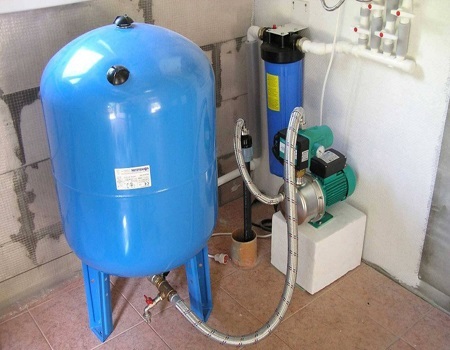
Accumulators are of different sizes. The installation type can be vertical or horizontal. The required volume should be selected based on personal needs
Problem # 2 - filter clogged
If the pressure in the water supply system is normal, and water does not come out of the gas column well, then you need to look for the cause in the water heater itself. Perhaps clogged filter or scale has formed.
And sometimes the column does not cope because of its insufficient power. Therefore, experts recommend buying gas inodon heaters power from 8 kW and more.
The most common problem with low hot water pressure is clogging coarse filter. All due to old piping systems that have not seen pipe replacement and repair in years. Microparticles of various debris get to us along with water through a pipeline. The filter "slows down" them and prevents them from leaking into the gas column.
Over time, a lot of debris collects and the water pressure becomes worse. Therefore, the mesh should be periodically cleaned.
You can find the filter on the pipe of the water reducer. It looks like a regular grid. If the water pressure was strong, the filter element could bend and get inside the pipe. The mesh should be removed and rinsed under running water. For the best effect, you can soak it briefly in an acetic acid solution.
Problem # 3 - scale formation
Over time, in the process of heating the water on the surface of the internal elements of the column, scale. The speed of formation of deposits depends on many factors: the hardness of the water, the frequency of switching on the heating equipment.
Scale in the heat exchanger tubes not only lowers the pressure in the system, but also increases the amount of gas used to heat the water.

If you do not fight scale, it gradually grows in the tubes of the heat exchanger and blocks the flow of water
Limescale can even provoke a breakdown of the water heater. Therefore, at the first signs of scale formation, you should do column cleaning.
Signs of limescale:
- poor pressure of hot water at the outlet of the heater;
- after a short heating, the protection (thermal sensor) is triggered;
- the column often turns on and off;
- the water heats up for a long time.
Descale in the heat exchanger using commercially available products or solutions specially prepared for these purposes. There are also non-chemical methods for dealing with limestone deposits.
Method # 1 - citric acid + cleaning instructions
When scale has formed and the gas water heater is clogged, not many people know how to clean it if there is no normal water pressure. The most correct thing, of course, is to seek help from professionals. But sometimes there is no time or extra money to call the master.
Therefore, many owners independently wash their water heaters from limestone deposits. A citric acid solution is used for this purpose. But this procedure should be performed carefully so as not to damage the parts of the gas device. If you smell gas, call the emergency services.
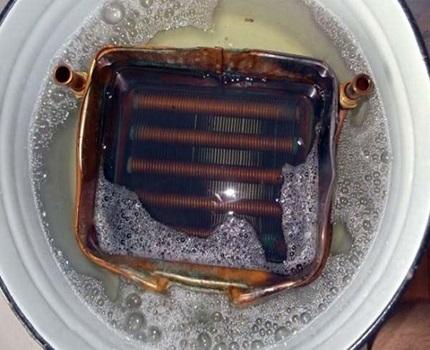
When the radiator is placed in a solution with lemon, all its elements must be completely covered with liquid.
Algorithm for self-cleaning of the column:
- We carry out preparatory work: we shut off the water and gas, disconnect the water heater from the network, drain the liquid from the equipment.
- We clean the mesh filter located at the inlet of the receiving unit. The mesh can be rinsed under normal water pressure. If there are calcium deposits, soak the filter in a citric acid solution.
- In the course of cleaning work, we check the membrane. If deformations are found on the part, we replace it with a new one. On one's own remove the membrane and put it back not difficult, since the unit is mounted by means of threaded connections.
- We remove the heat exchanger. It is not worth pulling it too much, you can damage the mount. If the nuts are acidic, they are hard to unscrew, then we take "VD-40" or a similar agent and apply it to the places of the threaded connections. After 20 minutes, you can already try to remove the heat exchanger.
- We soak the heat exchanger in a solution: 200 g of citric acid for 1 liter of water. Pour the resulting product into the radiator and leave it for 10-12 hours.
- We rinse the heat exchanger with water and mount it in its place. In the process of installing parts, be sure to check the condition of the gaskets, if necessary, install new ones.
- We open the water supply, make sure that there are no leaks.
- We smear the junction with the gas pipe with soapy water, check the tightness.
- We connect the gas water heater to the mains and heat the water.
This cleaning should be done every 2 years. If the water has high hardness values, then descaling is done more often.
Citric acid is quite popular for cleaning various appliances and household appliances. So, it is often used as an effective remedy for cleaning the washing machine.
Method # 2 - using phosphoric acid
Descaling in this way requires dismantling the radiator from the gas water heater. To circulate the agent through the radiator, you will need a special device and a 7-10% orthophosphoric acid concentrate.
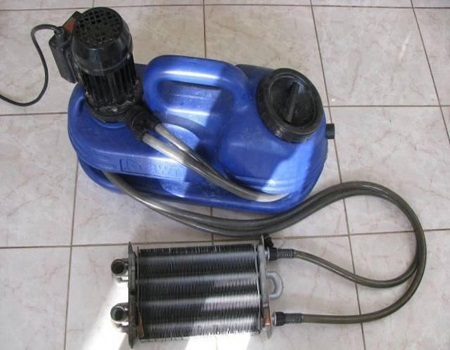
Consists of an apparatus for washing scale from a tank and a built-in centrifugal pump. Its use allows you to quickly and efficiently flush the column heat exchanger
The heat exchanger removed from the column is installed on a flat surface, after which the cleaning equipment with the reagent already poured is connected to it. The joints of the unit with the radiator inlet and outlet must be sealed, they can be insulated with electrical tape.
The descaling procedure takes about an hour. However, it all depends on the clogging of the radiator, if the layer of deposits is too thick, the flushing time may be increased. After that, the heat exchanger should be thoroughly washed from the remains of phosphoric acid and carefully mounted in its place.
Method # 3 - descaling with hydrochloric acid
A quick descaling of the column heat exchanger can be carried out using hydrochloric acid. To do this, take two pieces of a hose or pipe with a fitting: one part is connected to the radiator inlet, the second to the outlet. A funnel is attached to the first hose and raised above the level of the water heater. A 3-5% hydrochloric acid solution is slowly poured into the watering can.
Foam may form during rinsing. The tool quickly corrodes scale, if a strong pressure appears at the output, it means that the deposits have already dissolved. Be sure to rinse with rubber gloves, acid can injure the skin of the hands.
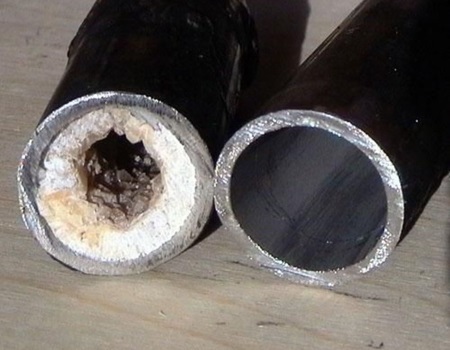
This is how pipes overgrown with scale look. Do not monitor their condition regularly and do not clean it in a timely manner, then the normal pressure of hot water cannot be restored
With the help of hydrochloric and other acids, it is quite easy to get rid of scale in a water heater. But you should be aware that such means can destroy metal parts, as well as their welded joints.
Therefore, it is better to flush by means of special closed-type equipment and use preparations intended for cleaning. Equipment for cleaning gas water heaters is sold in many stores. It supplies the working fluid under pressure along the circuit with the desired temperature.
During processing, the use of hydrochloric acid is alternated with several solutions. In this way, it is possible to avoid the negative effect of the reagents on the metal elements of the water heater. At the same time, various deposits are well removed and corrosion processes are prevented.
Scale can form not only in the radiator, therefore, the entire path of fluid passage must be cleaned from deposits. In the process of cleaning, the peculiarities of the materials of the parts and assemblies of the heater should be taken into account.

If the column reducer is aluminum, then it quickly fails when acid concentrates or aggressive detergents are used for cleaning. Therefore, many homeowners choose not to use the chemical method of cleaning the gas water heater.
Method # 4 - the use of electromagnetic technologies
Descaling is done by ultrasound - electromagnetic scale converter.
There are several variations of the ultrasonic filter design, which differ in power, as well as in the method of generating a magnetic field. The units are capable of protecting a section of the pipeline up to 2 km long from the formation of deposits.
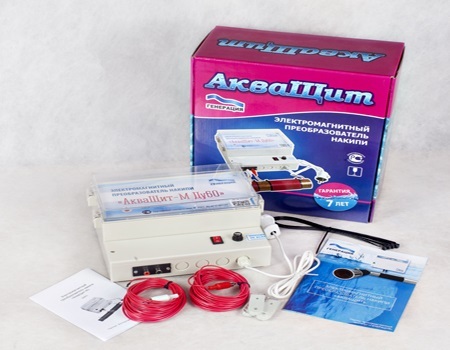
The picture shows an electromagnetic scale converter. This technique works from a 220 V network, while consuming electricity up to 20 W / hour
Mount the electromagnetic transducer in the area of the incoming water pipe without scale. That is, before starting the magnetic filter for the first time, you should rinse the heat exchanger and clean the water intake unit.
The device will generate magnetic pulses that soften the water, remove deposits and prevent new scale from forming.
Problem # 4 - faucet clogged
Not always a bad pressure of hot water indicates that it is the gas column that has clogged, sometimes the reason lies in the mixer itself. Sometimes debris from the water heater pipes seeps into the tap. A blockage can form in a thin rubber hose, filter, or other element.
To normalize the water pressure and fix the problem, you need to disassemble the mixer and wash off the accumulated dirt from the parts.

Most often, the filter mesh, which is installed on the "jib" of the mixer, is clogged. It is advisable to clean it periodically to avoid severe clogging and, as a result, a significant decrease in pressure.
If the pressure of hot water in the kitchen is normal, and the stream is weak in the bathroom, it means that filter clogged with debris. After flushing it, normal pressure will be restored. If the water quality is poor, then the "jib" filter mesh should be cleaned every month.
Due to the constant heating of water by a gas water heater up to 70 ° C or more, deformation of the rubber pad in the tap. The cut part will partially block the water flow, which will lead to a decrease in pressure. Therefore, here you cannot do without replacing the gasket.
Prevention of scale formation in the heat exchanger
In order not to suffer with the dismantling of the heat exchanger and its descaling, you should properly operate gas water heater.
It is easier to prevent the formation of salt deposits than to get rid of them later.

Any instantaneous water heater requires proper care. Service information for a specific model can be found in the instructions that come with the gas water heater.
Preventive measures:
- You should swim in water with temperatures up to +40 ° C. This temperature regime is good for health and does not harm the column.
- For washing dishes, a temperature of 45-50 ° C will be enough. The water will be comfortable for the hands and the grease will dissolve well.
- Washing can also take place at a temperature of 45-50 ° C. For stubborn dirt, an additional +5 ° C can be added.
The formation of solid deposits is accelerated temperature conditions with intensive heating up to +80 ° C. Scale begins to be deposited even on ideally smooth walls of the heat exchanger, and if there is roughness on the surface, then the fastening becomes "reinforced concrete".
Conclusions and useful video on the topic
Visual instructions for dismantling the coarse filter:
How the water heater is cleaned with household chemicals, see the video:
Poor flow of hot water from an instantaneous gas heater can occur for many reasons. The most common is the formation of scale, which appears as a result of prolonged use. You can get rid of it both with the help of purchased expensive means, and through solutions of various acids.
It happens that the pressure disappears due to clogging of the filters of the gas column or mixer. With proper care of equipment and plumbing, problems with low pressure of hot water can be easily avoided.
Do you want to supplement the above material with useful comments or point out the reason for the decrease in water pressure, which we did not mention in our article? Write your comments in the block below, take part in discussions, express your opinion on one of the issues raised by other site visitors.


